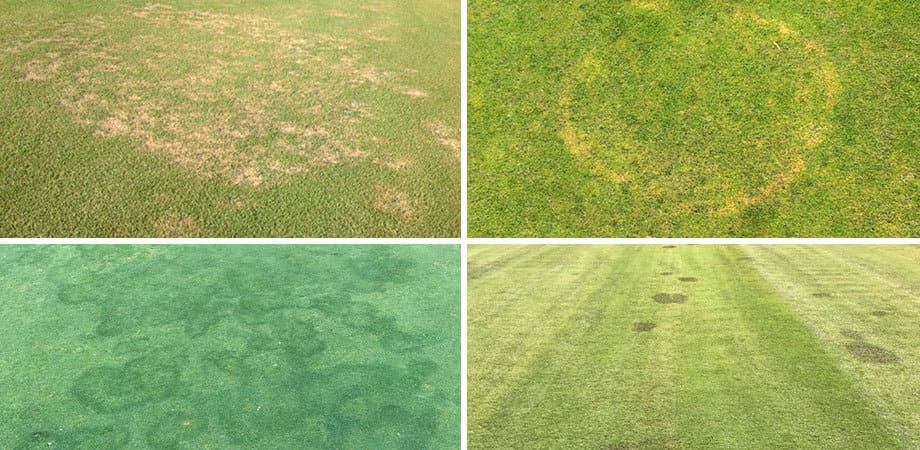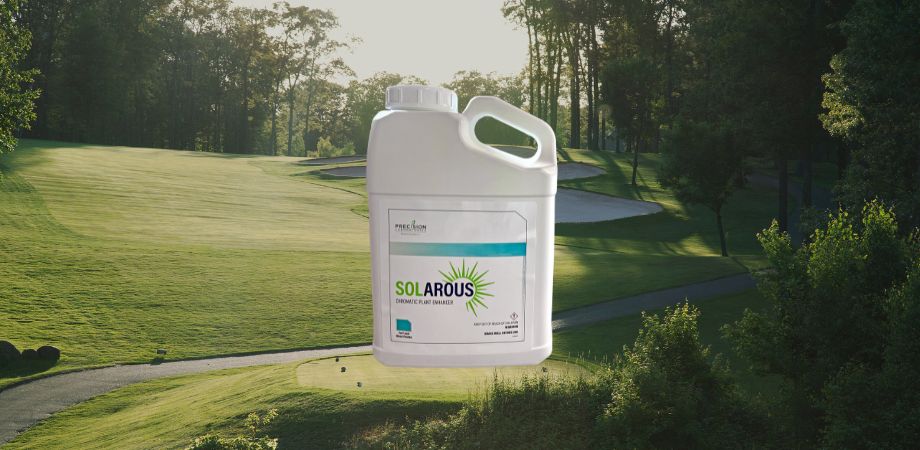Bermudagrass is a great turfgrass choice for greens, thanks in part to its tolerance to heat, traffic, damage, and more. It has a vibrant, beautiful color, too. Various diseases, however, can turn an otherwise gorgeous green into an eyesore and negatively affect playability. We’ll cover five diseases that commonly affect bermudagrass and how to detect, prevent, and eliminate them from the course.
Fairy Ring
First on our list is fairy ring, a turfgrass disease caused by fungi of the Basidiomycota division of fungi that form in a circle or “ring” and can present itself in several ways. Fairy ring symptoms will be visible as:
- A ring of grass that is higher and darker than other turf,
- A ring of dead, brown grass,
- A ring of mushrooms,
- Or a combination thereof.
Turf that is closely mowed and/or has a nitrogen deficit is especially susceptible, so bermudagrass greens are a prime target for this disease. It’s important to note that while fairy ring won’t kill your turf, it will still cause aesthetic and playability issues. The earlier symptoms are addressed, the better. Fungicides—especially those containing demethylation inhibitors (DMIs)—are the best bet. Apply fungicide when the soil temperature is around 55 to 60°F for preventative control. NC State Extension recommends watering in with ⅛ to ¼ inch of water.
- Product Options: Fame SC and Kalida are all effective fungicide options for fairy ring control.
- Temperature Range: 55-60°F
- Depth: 2 inches
Pythium Root Rot
Pythium root rot (PRR) is the product of water mold pathogens of the Oomecyte order. It attacks the roots of turfgrass, causing rotting and decay. The disease primarily affects cool-season turf, but some warm-season turf types, including bermudagrass, are susceptible, too.
When PRR strikes, roots become infected, appear brown, are water-soaked, and have a foul odor. Above-ground symptoms include streaks of yellowing, thinning, and dead patches. PRR thrives when it is hot and wet, but even areas with proper drainage can be affected since saturation is all it takes.
Fungicides labeled for use on Pythium should be applied preventively and should be watered in with ⅛ inch of water at a minimum to ensure the product reaches the root zone.
- Product Options: ArmorTech CYA 345 and Serata are fungicides that are specifically designed to control pythium root rot.
- Temperature Range: 60°F+ (heat stress will exacerbate symptoms)
- Depth: 2 inches
Take-All Root Rot
Take-all root rot (also known as take-all patch) is a root disease that harms bermudagrass from spring through fall. Symptoms appear when soil is compacted, drought-like conditions are present, and/or the soil is inundated with water. It’s caused by the Gaeumannomyces graminis fungus, which needs water to thrive, so multiple days of rainfall can exacerbate symptoms.
Take-all can be identified by its signature circular patches of dead or thin turfgrass. Rings are also common. Heat stress and dry conditions can create large patches of various sizes and colors, ranging from the standard brown and yellow to a grayish blue.
Cultural practices to prevent take-all include using ammonium and manganese sulfate, which can help decrease its severity. A proper soil pH (lower than 6.5) and good drainage can also help prevent take-all root rot. DMI fungicides are recommended for their efficacy against Gaeumannomyces, the disease’s causal fungus. Preventative fungicide treatments should take place during the fall when soil temperatures are below 60°F but above 45°F, as the efficacy of curative applications is limited. Water in with ¼ to ½ inch water immediately after applying fungicide.
- Product Options: Fungicides that control take-all include Tourney and Pillar G. Patch Amino 5 is a cultural alternative.
- Temperature Range: 55-60°F
- Depth: 2 inches
Leaf Spot
Leaf spot, also referred to as Helminthosporium leaf spot after the disease’s namesake fungus Helminthosporium (now reclassified under new species Pyrenophora and Cochliobolus) is a disease that causes dark-colored lesions to appear on turfgrass and an overall discoloration to the plant’s leaves. The disease thrives in wet conditions and when air temperatures vary between 60 and 65°F.
Ensuring ample fertility and choosing the right type of bermudagrass (a resistant type) can offset the risk of leaf spot. Removing thatch and proper irrigation practices are also recommended to prevent the disease. Apply based on label instructions.
- Product Options: Fungicides that control leaf spot include Kalida and Fame.
- Temperature: Prior to 60 to 65°F air temperatures
Mini Ring
Mini ring, also referred to as leaf and sheath blight, is a fungal turfgrass disease caused by Rhizoctonia zeae that harms bermudagrass—specifically the crown and sheath. The disease rears its head in the latter half of the year, with symptoms usually starting in late July or early August and continuing through October.
The disease causes rings of varying color—ranging from very light brown or yellow to dark brown or bronze-colored—to appear. These rings vary in size, ranging from three inches to up to two feet in diameter. Turfgrass that is either entering the dormant stage or growing relatively slowly during hot conditions is especially susceptible.
Applying urea nitrogen and raising mower decks can prevent symptoms and reduce their severity. However, also using preventative fungicides will be most effective. Fungicides will need to be watered in and applications should be made prior to air temperatures reaching 80°F. After application, lightly irrigate to allow the product to reach the thatch.
- Product Options: Fungicides that control mini ring include Affirm and Kalida.
- Temperature Range: Before 80°F (air temperature)
Final Thoughts
Some diseases are more aggressive than others, as are products. Always consult the product label to determine the appropriate application rate and determine if the product of your choice will require more than one application/intervals to be effective. Your ATS rep can work with you to determine which product is right for your course and fill you in on the finer details.












